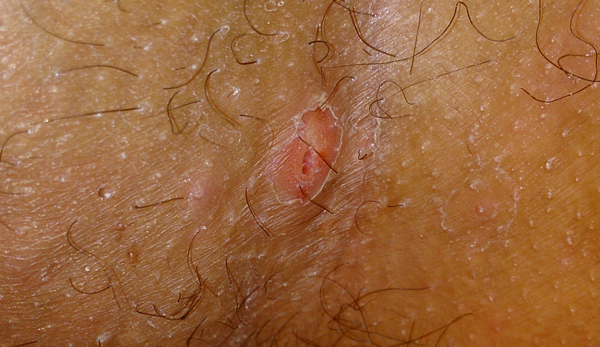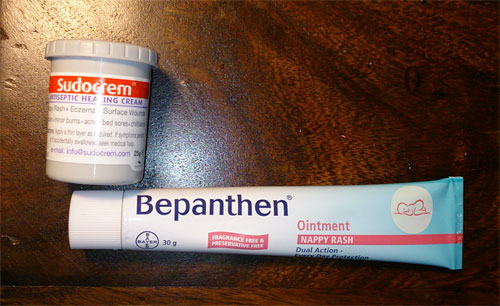The saddle sores we're most interested in are those caused by infection of a follicle in the perineum area.
Sores may also be caused by chafing. Chafing can easily be sorted out by changing shorts, adjusting the saddle position and by getting more time on the bike.
Saddle sores range from small unsightly to infected painful nodules which require surgery. Everyone gets them, but there are ways of minimizing their spread.
Sores may also be caused by chafing. Chafing can easily be sorted out by changing shorts, adjusting the saddle position and by getting more time on the bike.
Saddle sores range from small unsightly to infected painful nodules which require surgery. Everyone gets them, but there are ways of minimizing their spread.

You are looking at the join between the perineum and leg. This sore resulted from a new saddle causing abrasion. I needed to keep riding, so put a small hydrocolloid patch over it. This did the trick, as despite riding, 3 days later it had healed.
Remember to shave the area before applying the plaster, as the adhesion is strong!
Remember to shave the area before applying the plaster, as the adhesion is strong!
The perineum is a delicate area, but unfortunately this is the area in contact with your saddle for many hours. It doesn't get to see much sunlight, conditions are damp and hot and it is situated next to the anus. No wonder this is a breeding ground for bacteria, and saddle sores can be the result.
Saddle sores begin with the infection of a hair follicle. They will usually cause no problem and will resolve themselves with no intervention. However it is not difficult for sores to grow into pus filled buboes. More cycling will aggravate them, and they may even rupture inside your cycling shorts, causing the infection to spread. Surgery may even be required. We often hear about pro riders who have to miss races due to saddle sores.
These tips will help you to reduce the frequency saddle sores.
Always change your shorts after every ride
That means every ride. Whilst most people would not be keen on wearing a pair that had endured a long, hot cycle the day before, the issue here is re-wearing a pair of shorts that were only used for a gentle 10 minute spin. You might have felt that you didn't sweat much, so just put them back on the next day. The bacteria are still there and have had a chance to grow, and wearing these shorts will be a quick way to a crop of sores.
Perhaps it also needs to be said here: do not wear underwear whilst cycling.
The washing machine
Bacteria are killed at over 140F/ 60C, so it follows that a 140F wash will be required to properly clean your shorts.
Unfortunately 140F may also kill your Lycra. For example, Assos recommend no more than 86F/30C and use of a wash bag, delicate cycle and expensive Assos detergent. You'll need to experiment a bit in order to avoid ruined shorts that become see-through in just the wrong place (i.e. your butt crack).
I've personally found that my shorts don't deteriorate at 140F washes, but if you prefer a cool wash, try adding a disinfectant to the mix. Examples: Napisan, Dettol disinfectant liquid, Milton Antibacterial fabric solution, Eradicil laundry sanitiser and Halo detergent.
You may wish to avoid washing your shorts with the rest of your family's underwear, as this will spread other people's bacteria around your clothes. In the old days, professionals used to hand wash their own shorts in the hotel sink for this reason.
Make sure the shorts are inside out during the wash so the chamois will get a better clean.
Cleaning your perineum
Washing the perennial skin with detergents will lead to removal of so called friendly bacteria which aid in fighting off infection. Better to merely rinse the perineum with water. Allow some airing time afterwards.

Nappy rash creams act as a barrier between skin and infectious elements. The are antiseptic and offer some lubrication. Here we have Sudocrem and Bepanthen. another popular brand is Metanium.
Creams
Various creams can be applied to the perineum to cure or prevent saddle sores.
Chamois cream, such as Assos chamois crème, Udderly Smooth cream, Elite Ozone cream are spread liberally on the shorts before wearing. The effect is to make the area slippery whilst also acting as a disinfectant. I've personally found that these creams don't make any difference, and may even make things worse. My advice is to save your money, and just concentrate on good hygiene.
Nappy rash creams are also popular. For example Sudocrem, Bepanthen and Metanium. These work by forming a barrier between the skin and the irritant. They are also antiseptic. It gets rubbed off fairly quickly whilst cycling, and since you are unlikely to have urinated or defecated in your shorts, (unless you are a triathlete!) it isn't a miracle cure.
Anti bacterial/fungal creams such as germolene or canesten may help, but I'm more in favor of cleaning the area, letting it dry out then take a few days off the bike if the problem is severe.
For really severe problems which may require surgery, then see a doctor. He/she may prescribe antibiotics in severe cases (e.g. tetracyclines as used to treat acne).
Hydrocortisone cream should be avoided as it will thin the skin over time. Also you may fail a dope test, like Lance Armstrong in the 1999 Tour de France.
Change straight after riding
After cycling it is easy to spend an hour wandering around the kitchen or garage in your cycling kit. Meanwhile your undercarriage is staying damp and warm for longer than it needs to.
When you've finished your ride, get out of the Lycra and into the shower as soon as possible.
This may be difficult after races or sportives, but at least bring a change of clothes and perhaps some wetwipes to give yourself a quick clean. It also makes the drive home more pleasant.
Bike Fit and saddle type
If your saddle is too high it may lead to abrasions in the join between your leg and perineum. Whilst this doesn't cause infection, it can cause a lot of soreness and discomfort, even bleeding. Good quality cycling shorts should also reduce this problem.
However that doesn't mean you need to rush out and buy the most expensive shorts! Most mid-range shorts will do the job beautifully well these days. What's more important is that they are clean.
I have also seen a trend with cycle fitters to raise the handle bars due to inflexibility of the hamstrings. Lots of people are riding around with a stack of spacers under their stems. The problem with this is that it shifts more weight onto your backside, and the result will be more discomfort in the saddle area. Consider lowering your stem to resolve this issue. Remember, the fitters will be working to a formula and their experience, but you will be the best judge of comfort.
The wrong saddle can also cause a lot of discomfort, although not infection. There's no other solution than to try various saddles until you find one that suits you. Some bike fitting centers even offer pressure mapping. Save your money and just keep moving the saddle around until it feels comfortable. Again, the best judge of comfort will be you.

Tony Martin after the final time trial of the Vuelta al Pais Vasco 2014. Tony sticks skateboard grip tape (like sandpaper) to the top of his saddle to keep him in the perfect aerodynamic position. Unfortunately, it tends to eat through his shorts - sometimes too far.
Once you have a saddle sore
You may be able to squeeze the sore and pop it. This can be an eye watering experience. The release of pus and blood isn't for the faint-hearted. The area should then be disinfected to avoid spread of the infection, dried and left to heal. It might be a good idea to stay off the bike for a day to assist healing, but usually it is fine to carry on. Just keep monitoring it. Multiple draining sessions may be required. I'd avoid using needles or blades to lance boils as too much could go wrong here. Take it to a doctor if it is really bad.
I have also found that painful saddle sores, perhaps right at the contact point of pelvic bone and saddle, can stop being painful after 30-60 minutes of cycling. The nerve pathways become overloaded with pain signals and the brain ignores them. The rest of the ride can be completed in relative comfort and you can deal with the fallout when you get home. Which is to simply clean as advised and hope it gets better quickly, which it usually does.
Try shaving the area, then sticking a hydrocolloid plaster over the sore. Shaving is to prevent discomfort when you change the dressing. Leave the plaster on for 3 days. It will prevent further rubbing and will stop new bacteria from entering the site. Just trim the plaster to fit. Finally, in the 'old days' (before the 70s) they would put a steak in the shorts. The idea was that the raw meat would provide gentle padding for the area. Just remember to adjust your saddle height should you decide to do this. No, they didn't eat the steak afterwards!
Summary
The most important point regarding avoidance of saddle sores is to always wear a clean pair of shorts every time you ride. Don't wash your skin aggressively with soap and there's no need to apply lotions and potions to the area. Saddle sores are a fact of cycling, but proper hygiene should minimize the problem.
Links
Reskin plasters for the perineum. These are like hydrocolloid plasters, but marketed for cyclists.
